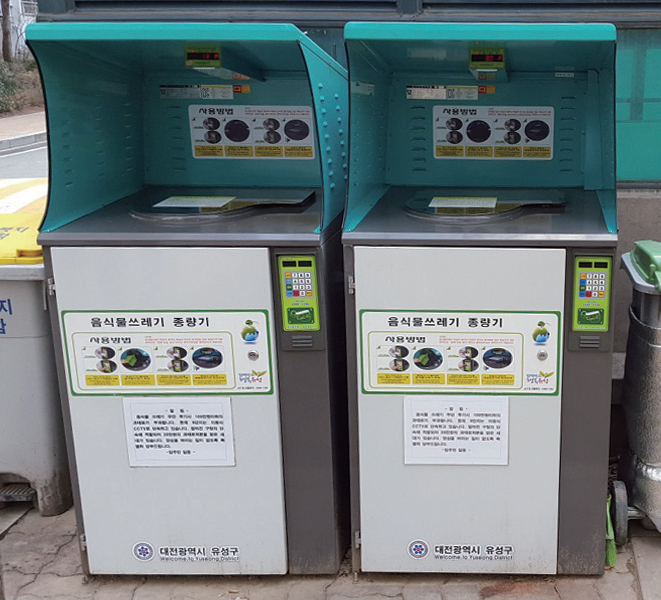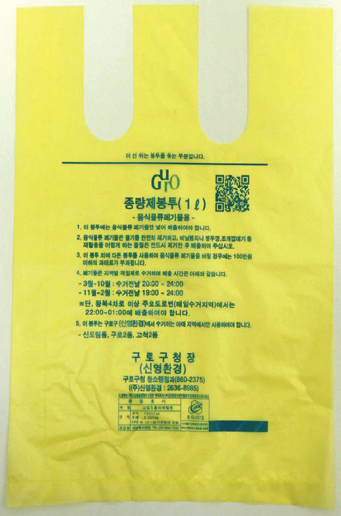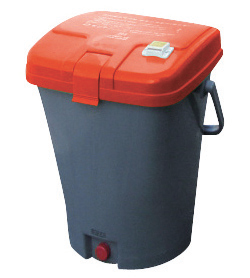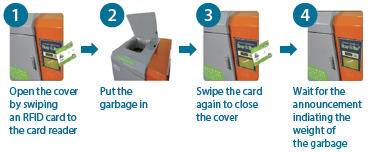As a solution to decrease the amount of food waste, the volume-rate garbage disposal system was established. Nevertheless, there were many side effects since 2013. As a result, a new system which integrated a Radio-Frequency Identification (RFID) function to the original system was introduced. Although it takes time to fully operate the system on a national scale, several areas including Gwangju City and Jung District in Seoul have already given the system a try and announced the effectiveness of the new RFID-based food waste management system last month. The Sungkyun Times (SKT) introduces this system, as most Kingos will potentially use it later on, its possible defects, along with the ways in which the system can be improved to be more eco-friendly.

Background of RFID-Based Integrated Food Wastes Management System
The RFID-based Integrated Food Wastes Management System is a system that only operates in Korea for very particular reasons.
Unique Features of Korean Cuisine
Korean people generally eat soups and stews in the majority of their meals, which brings about the excessive amount of wet food waste. If wet waste is buried or incinerated before complete desiccation, it burns incompletely, letting out a stench and creating possible leak of leachate from the landfills. Additionally, this unique food culture increases the volume of waste significantly. According to a research from the Korea Waste Association, the percentage of food waste out of all household wastes estimated to about 28% in 2014. Considering that the OECD countries are recommended to reduce the percentage of food waste to five percent, Korean food waste should be decreased by a fifth. This is not the only problem, though, as the energy and financial losses due to the food waste are also severe. In 2010, 800 billion were spent on the disposal of food waste, and 724kg of greenhouse gases and 718kw of energy were wasted from the food waste that one household of four people produced.
Change in the Way to Dispose of Food Waste
Before 2013, Korea classified solid food waste and liquid food waste differently. While solid food waste was used to make compost and fodder, liquid waste was purified or disposed of in the East Sea or the Yellow Sea. This disposal method, however, had to be changed because of the London Dumping Convention. According to the London Dumping Convention, contracting parties shall “prohibit the dumping of any waste or other matters,” in which dumping refers to the “deliberate disposal at sea of wastes or other matter.” Therefore, the Korean government had to come up with a new way of dealing with food waste.
Problems with the Previous System
Before the RFID-based Integrated Food Wastes Management System, the volume-rate garbage disposal system with dedicated garbage bags, payment chips, and stickers were used to throw food waste away. The volume-rate garbage disposal system is an incentive policy in which citizens pay a fee in proportion to the volume of food waste they produce. The system of using dedicated garbage bags was used among people living in apartments. They had to put waste in dedicated garbage bags and dispose of them directly. This policy, however, resulted in secondary environmental pollution because homeless cats and dogs damaged the bags. Additionally, the dedicated garbage bag itself was another type of waste needing proper disposal. The system using payment chips or stickers worked similarly and had similar side effects to plastic bags. This was used among citizens living in detached houses or workers in small restaurants, putting the waste into their own containers. Unfortunately, these policies faced fiscal difficulties as the government was running low on funds for the management of the whole system itself, especially for the stickers and chips.


The System That Suits the Policy the Most
In February, 2010, the Presidential Committee on Green Growth came up with three types of solutions. Among them, the RFID-based Integrated Food Wastes Management System was the most appropriate since the weight of the waste and the information about the user is shown as users throw away the waste. This also gives users the motivation to decrease their waste.
What is RFID-based Integrated Food Wastes Management System?
The RFID-based Integrated Food Wastes Management System is a type of volume-rate garbage disposal system using RFID technology. RFID is a technology that sends the information about the production, distribution, storage, and consumption of the product it is applied to when a reader checks the information stored in the tag. This is a technology widely used in daily life, such as in transportation cards or tags attached to clothes in distribution centers. It is similar to barcodes in its uses, but since it can save much more data and be fixed by manipulating radio frequencies, RFID is more widespread. This system can be divided into three categories depending on the weighing methods: separate, vehicle, and portable. Users are allowed to pick the method they are most happy with.
To use the RFID-based Integrated Food Wastes Management System, the user scans the RFID card to the device and disposes of the waste. The information about the user and the weight of the disposed waste is then automatically sent to the central management system of the local government. The user can always log-in to the local government website and check how much food waste they have disposed of and the fee they should pay. The fee is originally paid afterwards, and only users of a separate weighing system can pay the fee with a prepaid card right as they dispose of the waste. Since the user can directly see the weight of the waste and fee, this system is expected to have a strong effect on decreasing the rate of waste production. Additionally, the gathered information can be used by the government to manage the fees and to enact more effective food waste policies based on the statistics provided. Several regions including Jeonju, Jeju, Daegu, Daejeon, and Jung District in Seoul have already carried out this system as trial.

The Effects of Demonstration
Jeonju
Jeonju was selected as the first city to attempt the RFID system because the amount of food waste was about 20% higher than the average. Before the enforcement, the amount of disposed food waste was increasing steadily. After the enforcement, however, about 12% of waste decreased within eight months. Moreover, the government provided more incentives to less motivated households to activate the system more proficiently. Shin Kyung Sup, the director of the Green Environment Bureau of Daegu, said that the weight of food waste decreased by 30% after the introduction of the system, and that other cities were starting to talk about their own products.
Jung District, Seoul
In Jung District, 178 RFID devices were made and used by 9,043 people living in seven apartment complexes. As a result, the waste decreased by about 30% up to this August and the device will be installed all over the district.
Opinions of People in Use and Problems Revealed
Ms. Seok (20), Seoul
Q1. What efforts have you made to decrease food waste after the introduction of this system?
Since the weight of the waste shows up when I throw away garbage, I keep reminding myself of the fact that I should decrease the amount of food waste. Therefore, our family cooks only the amount we can eat, and we
avoid eating food involving too many bones.
Q2. What are some good and bad aspects of this system?
• Good - The cover that opens automatically is the best part of this system.
• Bad - The problem is that the area surrounding the device is still dirty. It did not become any cleaner than before.
Ms. Lee (28), Jeju
Q1. What efforts have you made to decrease food waste after the introduction of this system?
I try to squeeze all the water out the waste and I started using the smallest garbage bag to collect food waste.
Q2. What are some good and bad aspects of this system?
• Good - Since the cover opens automatically when I touch the device with the card, I don’t have to open the container with my hand and wash my hands after disposal.
• Bad - If I lose my RFID card, I cannot throw the waste away and have to wait for reissuance.
Ms. Jang (20), Daejeon
Q1. What efforts have you made to decrease food waste after the introduction of this system?
I try not to make food waste by buying the minimum amount of food necessary and eating it all without any leftovers. I also stopped leaving food in the fridge for far too long so I can finish it before it goes bad.
Q2. What are some good and bad aspects of this system?
• Good - The system that opens the cover when I scan the card to the reader is very nice. It made throwing away the food waste much cleaner and convenient.
• Bad - Since I can only go to dispose of the waste when the garbage bag is full, I cannot put it away whenever I want to. This drawback, however, helps me keep trying to decrease the waste since I have to buy more bags when there is too much waste.
Problems
The problems stated above can be organized as follows:
High Cost in Maintaining and Repairing the Device
In 2013, Gangnam District stopped using the RFID-based Integrated Food Wastes Management System and went back to using the original system due to a financial crunch. To maintain the devices used as trials, a budget similar to the initial cost is needed. Additionally, if the device becomes older, it needs be replaced with a new one, which will double the amount of money than the previous system.
Lack of Awareness about the System
The RFID-based Integrated Food Wastes Management System is effective in decreasing the food waste because it encourages individuals to decrease the weight of waste on their own will. As shown in the interview, most people who are aware of the system put efforts to decrease the waste. On the other hand, there are people who do not even know that there is such a system and do not change their behaviors.
Hygiene Problems Unresolved
One of the most serious problems of the original system was that the area near the dump was dirty. As the government advertised the RFID-based Integrated Food Wastes Management System, people claimed that this problem would definitely be solved. However, residents are criticizing that the same method of storing and picking up the waste is resulting in the same problem.
As the new system has been introduced, the disposal of food waste is becoming more convenient. However, problems arise as people become familiar with the system. To make a more eco-friendly disposal of food waste possible, the government should try to improve the systems and techniques. Above all, however, the active effort to decrease the amount of food waste is the main factor that makes this system eco-friendly. The SKT hopes Kingos will be more aware of the environment and decrease the waste they dispose of.
